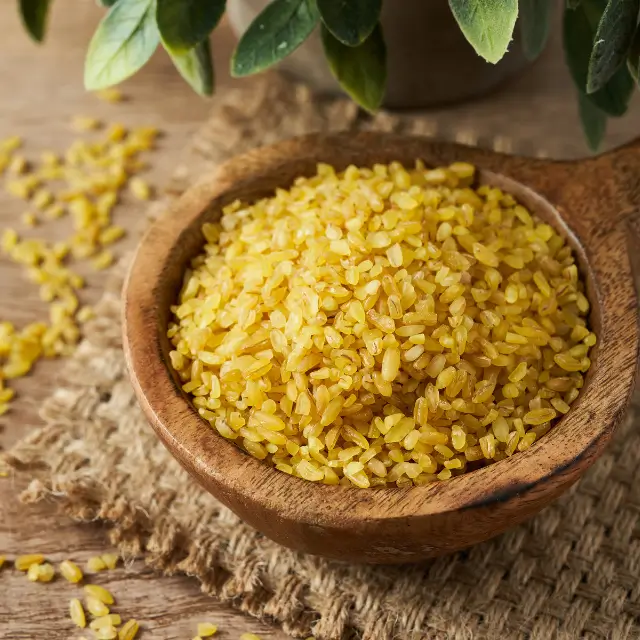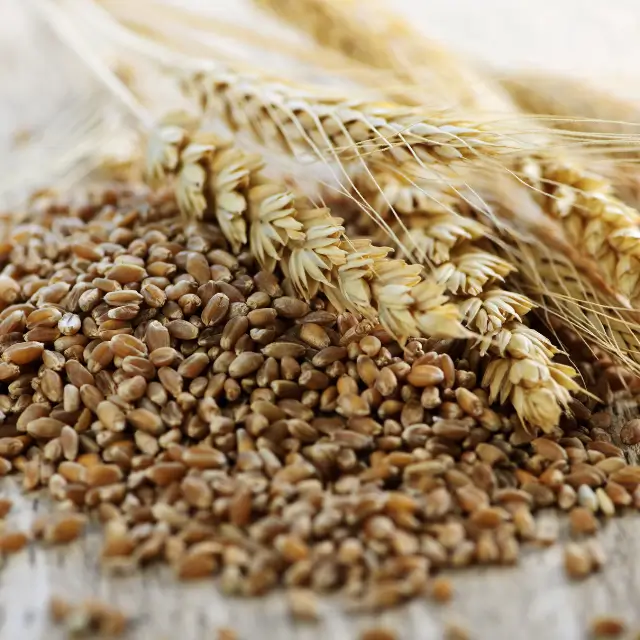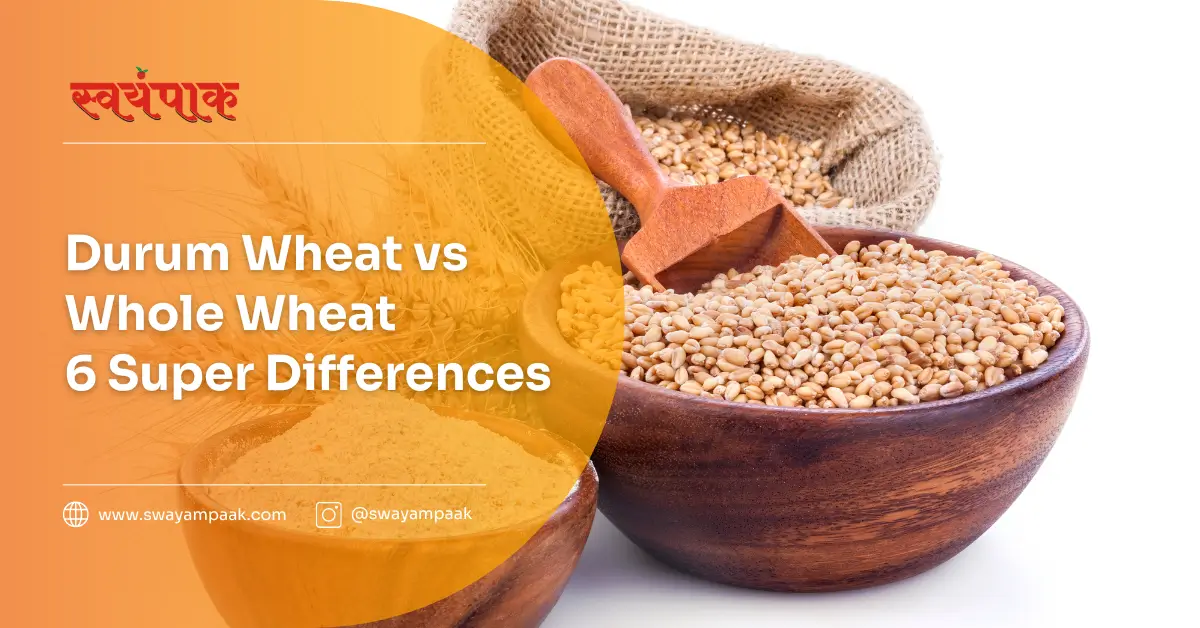Durum Wheat vs Whole Wheat: Which Flour Should You Choose?
Durum wheat and whole wheat are both nutritious, but differ in protein content, dough behaviour, and ideal kitchen uses.
Durum wheat is the hardest wheat with higher protein and great extensibility, perfect for pasta and semolina. In contrast, whole wheat (common wheat) retains bran and germ, making it softer and ideal for bread, chapati, and everyday baked goods.
👉Use durum for firm, stretchable doughs like pasta; use whole wheat for softer, elastic doughs like bread or rotis.
Here’s what you’ll learn:
- ✅ Composition and nutrition differences
- ✅ How each flour behaves in dough
- ✅ Best baking and cooking applications
- ✅ Tips for choosing flour depending on recipe type
What’s the difference between durum wheat and whole wheat?
Durum wheat: High in protein, used for pasta, with less fibre
- Whole wheat: Contains bran and germ, more fibre, used in chapatis/bread
Durum is ideal for pasta due to its gluten strength. Whole wheat is better for everyday cooking because it retains more nutrients and fibre.
- Durum Wheat vs Whole Wheat: Which Flour Should You Choose?
- Durum Wheat: The Golden Grain of Pasta Perfection
- Whole Wheat: The Powerhouse Grain
- Durum Wheat vs Whole Wheat: A Head-to-Head Comparison
- Durum Wheat vs Whole Wheat
- A Tale of Texture and Taste
- Choosing Your Grain Champion: Durum Wheat vs Whole Wheat
- Conclusion
Durum Wheat: The Golden Grain of Pasta Perfection

Durum wheat, boasting a beautiful golden colour, stands out from the crowd. This hard wheat variety is a champion of gluten, making it ideal for creating the perfect pasta.
Originating in the Middle East, durum wheat has travelled the world, finding fertile ground in countries like Italy, the USA, and Canada. This versatile grain isn’t just about pasta, though. It’s also ground into semolina, a coarse flour used in various dishes.
Nutritional Profile:
Durum wheat isn’t just about creating the perfect al dente pasta. This golden grain packs a nutritious punch! Rich in protein and B vitamins, durum wheat fuels your body and keeps you feeling energised.
But that’s not all! Durum wheat is a source of essential minerals like iron, which is important for oxygen transport, and magnesium, which supports muscle and nerve function. The secret behind that satisfying chew in your pasta?
It’s the high gluten content of durum wheat, creates a springy texture that holds its shape perfectly. So, the next time you enjoy a pasta dish, know that you’re not only indulging in taste but also reaping the health benefits of this golden grain.
Whole Wheat: The Powerhouse Grain

Whole wheat isn’t just a type of flour; it’s a commitment to capturing the full potential of the wheat kernel. There are different types of wheat with a variety of uses. Unlike refined grains that undergo processing, stripping away the bran and germ, whole wheat embraces all three parts:
- Bran: This outer layer is packed with fibre, aiding digestion and promoting gut health. It also contains essential minerals like iron, zinc, and magnesium.
- Germ: This nutrient-rich core is the embryo of the wheat plant, loaded with protein, healthy fats, vitamins B and E, and various antioxidants.
- Endosperm: This starchy centre provides carbohydrates for energy. While lacking the nutrients of the bran and germ, it’s still a valuable source of sustained energy.
Whole wheat boasts a significant nutritional advantage over refined grains. The fibre in the bran keeps you feeling fuller for longer, while the vitamins and minerals from the germ contribute to overall health and well-being. Incorporating whole wheat into your diet isn’t just about taste; it’s about giving your body the full spectrum of nutrients this powerhouse grain offers. The various types of parathas and rotis in India generally use whole wheat.
Nutritional Profile:
Whole wheat isn’t just a whole grain; it’s a champion for digestive health and overall well-being. Here’s why:
- Fibre Fiesta: Whole wheat boasts a remarkable amount of dietary fibre, particularly the insoluble fibre found in the bran. This fibre acts like a broom in your digestive system, promoting regularity and keeping you feeling fuller for longer. This can be helpful for weight management as it reduces cravings and helps maintain a healthy appetite.
- Vitamin and Mineral Vault: Whole wheat goes beyond fibre. It’s a treasure trove of essential vitamins and minerals. Vitamin E, a powerful antioxidant, protects your cells from damage. B vitamins, abundant in the germ, are crucial for energy metabolism and brain function. Minerals like iron, magnesium, and zinc are vital for oxygen transport, muscle function, and a healthy immune system.
- Digestive System Ally: The combination of fibre and B vitamins in whole wheat makes it a digestive system’s best friend. Fibre promotes the smooth movement of food through your gut, while B vitamins aid in the breakdown of carbohydrates for energy. This reduces bloating and discomfort, contributing to overall digestive well-being.
Durum Wheat vs Whole Wheat: A Head-to-Head Comparison
| Feature | Durum Wheat | Whole Wheat |
|---|---|---|
| Scientific Name | Triticum durum | Triticum aestivum |
| Kernel Color | Amber | Reddish-brown |
| Texture | Hard | Varies (can be hard or soft) |
| Protein Content | High (12-15%) | Moderate (10-12%) |
| Gluten Strength | Strong and elastic | Variable (depends on the type of wheat) |
| Common Uses | Pasta, couscous, semolina | Bread, pastries, baked goods |
| Flavor | Nutty, sweet | Earthy, robust |
| Nutritional Value | High in protein and fiber | Rich in fiber, vitamins, and minerals |
Durum and whole wheat share some common ground nutritionally. They’re both good sources of protein and B vitamins, along with containing iron. However, some key differences emerge. Whole wheat takes the lead in fibre content, boasting a “high” amount compared to durum’s “moderate” level. This makes whole wheat a more attractive option for those seeking digestive health benefits.
While durum reigns supreme in gluten content, ideal for creating springy pasta, whole wheat has a “moderate” amount. This can be beneficial for people who are gluten-sensitive but still want to enjoy some wheat products. Finally, whole wheat edges out durum in magnesium content, offering a slight edge in supporting muscle and nerve function.
Durum Wheat vs Whole Wheat
The Pasta Champion
Durum wheat reigns supreme in the world of pasta. Its high gluten content creates the perfect dough for those satisfyingly al dente noodles. Durum also shines in couscous, those tiny steamed balls of semolina flour, a coarse product of durum wheat. Beyond pasta and couscous, durum even finds its way into some speciality bread, like semolina bread, known for its light and airy texture.
A Baking Powerhouse
Whole wheat takes centre stage in the realm of baked goods. From hearty whole wheat bread to the sweet indulgence of whole wheat muffins, this versatile grain adds a nutty flavour and a delightful textural contrast. Whole wheat flour isn’t just for Western cuisine; it plays a vital role in traditional flatbreads like chapatis, a staple food in South Asian cultures. So, next time you’re looking to add a touch of wholesome goodness to your baking, reach for whole wheat flour and discover a world of delicious possibilities.
A Tale of Texture and Taste
The Chewy Delight
Imagine twirling a forkful of perfectly cooked pasta – that’s the textural signature of durum wheat. Its high gluten content translates to a firm, satisfying chew. Durum also boasts a subtle nutty flavour, complementing various sauces and ingredients.
This is why pasta made from durum wheat is revered for its ability to hold shape and texture throughout cooking, ensuring that al dente perfection on your plate.
A Dense and Flavourful Journey
Whole wheat takes you on a textural adventure. Compared to its refined counterpart, whole wheat products possess a denser texture, attributed to the bran and germ retained in the grain.
But density isn’t its only story. Whole wheat flour brings a richer, more robust flavour to baked goods. Bite into a slice of whole wheat bread, and you’ll experience a depth of flavour missing in white bread. This robust taste profile makes whole wheat a perfect canvas for a variety of ingredients, from sweet additions like honey and nuts to savoury cheeses and herbs.
Choosing Your Grain Champion: Durum Wheat vs Whole Wheat
While both durum and whole wheat offer valuable nutrients, the ideal choice depends on your specific needs and culinary goals.
Tailoring Your Grain to Your Goals:
- Fibre Fanatic? Go Whole Wheat: Whole wheat reigns supreme for those seeking a fibre boost. Its high fibre content aids digestion and promotes a feeling of fullness, making it a great choice for weight management.
- Pasta Perfection? Embrace Durum: Durum wheat is the undisputed champion for crafting delicious pasta. Its high gluten content creates the perfect dough, resulting in firm, chewy noodles that hold their shape beautifully when cooked.
Taste and Texture Preferences:
Beyond fibre content, consider your taste and texture preferences. Whole wheat offers a denser texture and a richer, more robust flavour profile, ideal for breads, muffins, and flatbreads like chapatis. Durum wheat, on the other hand, boasts a milder flavour and a satisfyingly firm, chewy texture, making it the perfect canvas for pasta dishes and light sauces.
Embrace the Power of Variety:
The beauty lies in incorporating both grains into your diet! Enjoy the digestive benefits and mineral richness of whole wheat in your daily bread or breakfast cereal. And, don’t shy away from savouring a perfectly cooked pasta dish made with durum wheat when your taste buds crave a satisfyingly chewy meal.
Decoding the Labels:
Reading labels is key to ensuring you get the full benefits of each grain. Look for products labelled “whole wheat” to guarantee you’re getting the bran, germ, and endosperm for a complete nutritional package.
When choosing pasta, opt for brands that specify “100% durum wheat” or “semolina” to ensure the authentic texture and quality associated with this unique grain.
By understanding the strengths of durum and whole wheat, you can make informed choices that not only satisfy your taste buds but also contribute to a balanced and nutritious diet.
Conclusion
In summary, both durum wheat and whole wheat offer unique benefits and are suited to different culinary uses. Durum wheat shines in pasta and other firm-textured dishes, while whole wheat is a nutrient-rich option for baked goods and everyday meals.
By understanding their differences and benefits, you can make informed choices and enjoy the best of both grains in your diet.

